A Guest Article by Mark Mullen
The majority of most BJJ’ers training time is spent attending structured classes at their academy. And most academies divide their structured classes into 3 portions:
- A warm up (which usually includes some physical conditioning),
- A technique portion where we learn a new position or technique, and then we pair off with a partner and try the techniques,
- Free rolling or positional sparring in timed rounds
After class we typically we bow off of the mats, get changed back into our street clothes, and run on to our next obligation…
Many students are fortunate, however, to also have access to an open mat time at their academy. During open mat they they can meet with training partners in an unstructured session and do whatever they wish.
Here are 5 ways that you can use that open mat time to improve your BJJ and become a more complete grappler overall.
1) Got Judo?
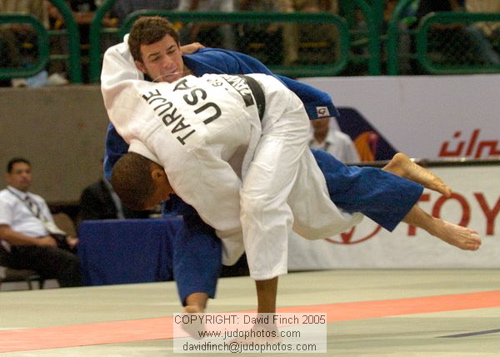 In many BJJ academies up to 90% of the training is on the ground. In part this is because the mat can get pretty crowded during class times, and therefore having some guys do standup grappling while other people are on the ground can be dangerous. For this reason, the entire class starts the sparring from the knees or in your partners guard.
In many BJJ academies up to 90% of the training is on the ground. In part this is because the mat can get pretty crowded during class times, and therefore having some guys do standup grappling while other people are on the ground can be dangerous. For this reason, the entire class starts the sparring from the knees or in your partners guard.
But training throws and other standing techniques is still an important part of training! I like to think of Judo as not only the standup portion of BJJ, but also as a fun and interesting training modality that helps you understand balance, momentum, explosiveness, and strategy. Highly regarded trainer Dave Camarillo uses the term “complete grappler” to refer to having a complete grappling set of skills, which includes proficiency in takedowns.
Many top BJJ Black belts also have black belts in Judo. The head instructor at my academy trained at Gracie Barra, Brazil. While he was there, he says, the technique that head instructor Carlos Gracie Jr. was most fond of showing was his Ouchi-gari to Osotogari combination.
Open mat times provide you with the opportunity to start your matches standing and work for takedowns. If you haven’t done much standup grappling in your BJJ thus far you may be surprised at how fatiguing it is, due to your unfamiliarity with that range of fighting.
Judo training usually starts with the breakfalling (how are your breakfalls?), and then repetition of the throws which is called ‘Uchikomi.’ Dozens of repetitions of the entering part of the throw may be executed during Uchikomi, and training like this is a great warm up.
The Judo ‘Gokyo’ (collection of throwing techniques) has 67 different techniques – but you may be surprised to learn that international level competitive judoka actually only use 2-4 main techniques. For your own practice, one really need only learn a few basic, high percentage throws and then spend the majority of your time becoming proficient with them. Read this interview with Judo Olympian Daniel McCormick for an interesting perspective on Judo for BJJ.
Try several throws and you’ll find that one works best for your body type and physical attributes. Then learn what other throws work best in combination with that ‘bread and butter’ throw. This is the start of you developing a strategy for standup.
Then go a little further and learn which grips are best to execute your throw (BJJ has far fewer gripping restrictions than sport Judo) and what counters you need to be aware of. At that point you’ll be well on your way to developing your own throwing game!
2) Position Focused Training
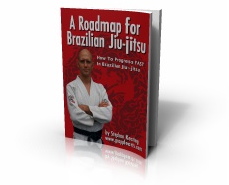 Most BJJ classes will feature a set of techniques clustered around a certain position – open guard sweeps for example. The following class you may jump to side mount and not return to the open guard for several weeks.
Most BJJ classes will feature a set of techniques clustered around a certain position – open guard sweeps for example. The following class you may jump to side mount and not return to the open guard for several weeks.
Especially in the early stages of your training, you need to touch on all the different positions so as to obtain the big picture of the art (the big picture is laid out for you in the free book by Stephan Kesting called “A Roadmap of BJJ”). So it’s natural that, at first, you gain exposure to a larger surface area of BJJ, but this does come at the expense of delving deeper into a specific area.
To really achieve a deeper knowledge of a position (for example, the butterfly guard and its variations) you need to apply your focus to that one position over several weeks, or even months. The first person I saw doing this was my oldest BJJ training partner – Stephan Kesting of Grapplearts. Stephan would develop an obsession about a certain position, and at every spare moment – in the few minutes before class got started, instead of free sparring at end of class or at open mat – he would pull me over to the edge of the mat and ask, “Can I try something here? Get in my butterfly guard…”
Over a period of months he experimented with each variation, setup, grip, submission and counter – eventually developing both the mental framework for the position / game plan, and getting enough physical repetition to make the movements instinctive. Our coach, Marcus Soares, watched this experimentation and dubbed him with the nickname “the Mad Scientist of jiu-jitsu”. I recently adopted Kesting’s methodology for my own 6 month study of the back position, and I progressed more in 6 months than in the previous 5 years of regular training.
I often ask experienced blue belts and purple belts at my academy this question: “what is YOUR guard?” When they ask me to clarify I explain that there are many different types of guards, and that since it is impossible to achieve expert level in all of them, they must have found a guard position suits their game best. If knowing what guard suits you best is still a mystery, then you need to start the fun experiment of trying out all the various guard styles (including the closed guard, the open guard, and the half guard) in order to find a couple that seem to click with you, and then set aside the rest.
Once you have a starting point you can then concentrate your training on the variations. However, in the weekly BJJ classes, the instructor may not get around to covering techniques in your new guard obsession for months!
Open mat is the opportunity to get in the physical repetitions and test-drive your new guard variations to find out what works and – just as importantly – what DOESN’T work in the less intense BJJ laboratory of the open mat. Take chances; try variations that you wouldn’t dare try in more intense sparring matches in class. If you do this then your effectiveness in a specific position will increase much faster than it would if you just trainined it during regular class.
Let’s say you train Karate or another striking art and the instructor showed you a specific punch or a kick… Would you bang through 10 sloppy repetitions and then declare, “Ok, I got it! What’s next?” Of course not! When it comes to striking you need LOTS of repetition to develop your muscular strength, endurance, coordination, balance, hip torque and efficient weight shifting. Why should BJJ armbars or guard sweeps be any different?
Ed Beneville, in his excellent book “The Guard,” sums it up by saying, “repeating physical movements ingrains neurological pathways which can be retraced with less and less concentration as they become well worn. As adults we no longer think much about how to walk , but once we did. Repetition develops coordination.”
3) Wrestling for BJJ
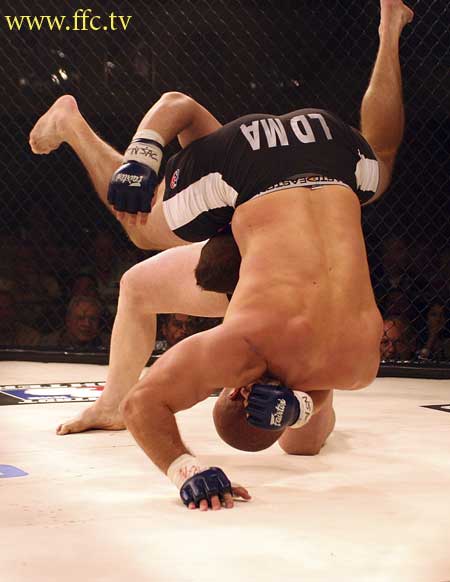 With the strong wrestling base in North America and the prevalence of high level wrestlers in MMA, a wrestling influence has definitely crept into BJJ. Anyone rolling with a competitive wrestler will quickly recognize that they have their hands full, even though the wrestler has little experience of submissions! A wrestler’s base, ability to scramble, mental toughness and willingness to apply weight and leverage to their opponent can be difficult to deal with.
With the strong wrestling base in North America and the prevalence of high level wrestlers in MMA, a wrestling influence has definitely crept into BJJ. Anyone rolling with a competitive wrestler will quickly recognize that they have their hands full, even though the wrestler has little experience of submissions! A wrestler’s base, ability to scramble, mental toughness and willingness to apply weight and leverage to their opponent can be difficult to deal with.
For the BJJ practitioner, the good news is that an extensive knowledge of wrestling techniques is not required to gain an edge over your opponents. Even knowing only a few of the proper grips (or “ties”) allows you to dominate the clinch and defend against your opponent’s attempts to take you down. Many BJJ’ers, accustomed to starting the roll on the ground, have little experience in dealing with collar ties, whizzers, or underhooks. This leads to rapid fatigue in the unfamiliar range of standup grappling, before ultimately ending up on the bottom to start the match.
There are 2 main benefits from adding a little wrestling to your BJJ. The first benefit is pretty obvious:
Takedowns.
When I first started BJJ, my instructor Marcus Soares surprised me by emphatically stating that he didn’t like the strategy of jumping to guard in competition. Since there are more submission options from the guard than any other position in BJJ, and BJJ’ers are known for the proficiency in fighting from their backs, I asked him to clarify. It turned out it was all about staying on top: he said, “If the match ends with no points for either side, the referee will usually decide in favor of the competitor who stayed in the top position.”
In a closely contested match the victory may go to competitor was able to take and hold the top position, and one takedown can definitely decide a match. Observe matches in ADCC and the Mundials and you’ll see that LOT of them are decided by the 2 points scored during a takedown. Andre Galvao – ADCC 2011 Absolute Champion – credits his improved performance to the study of wrestling.
The second main benefit from wrestling is:
Improved scrambling ability.
Many BJJ practitioners are accustomed to surrendering top position in scrambles, conceding to fight from their guard or 1/2 guards. It’s true that the most important position in BJJ may be the guard. However when one considers the different applications of BJJ (sport competition, MMA, no-gi, self defense, etc), achieving the top position over a competitive opponent can become more important than fighting off of your back.
I heard a recent podcast with Dave Camarillo where he commented (and I paraphrase) about wrestling being the “best grappling art” because it allows you to control where the fight goes – especially the top position – in MMA. In a high intensity match against an aggressive opponent who is every bit as determined as you to win, a common wrestling technique such as a switch or sit out may prevent you from ending up fatigued, on the bottom, and carrying the weight of your opponent.
A pro MMA fighter from my academy put it simply, “In a hypothetical match of you against yourself, who would win? Top or bottom?” Sitouts, switches, and other wrestling techniques are tools that allow a different option for when a position has been broken and both opponents are looking for an advantage in the ensuing scramble.
Most academies have one or two former wrestler who would be more than happy to show you the fundamentals of a short arm drag, a snapdown, or other wrestling basics. All you need to do is ask.
A little wrestling may just give you that competitive edge we are all looking for.
4) Ginastica Natural / Yoga Movements
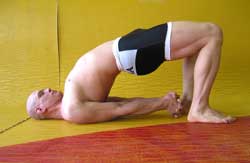 Even a 1.5 hour BJJ class doesn’t allow for adequate time to thoroughly stretch all of the main muscles groups and joints. After the rolling which typically concludes most BJJ classes, most people end up chatting about the upcoming UFC while getting changed and then out the door.
Even a 1.5 hour BJJ class doesn’t allow for adequate time to thoroughly stretch all of the main muscles groups and joints. After the rolling which typically concludes most BJJ classes, most people end up chatting about the upcoming UFC while getting changed and then out the door.
But most of the people leaving so quickly would also readily acknowledge that they’d benefit from more comprehensive flexibility training…
Benefits of a flexibility program for BJJ’rs include:
- Moving more easily, which stops fatigue from setting in as quickly,
- Greater amplitude in the range of motion, which may protect against joint and muscle injuries,
- Most practitioners tend to favor one side of their bodies when performing their techniques. Over a long period of time this will develop muscle and flexibility imbalances. A well thought out stretching program will identify and begin to rectify those imbalances,
- If you’ve ever injured one side of the body, you may have developed an unconscious habit of compensating and trying to hide that side of your body. Over a long period of time the initial injury can lead to an asymmetry in your flexibility and degree of joint movement. A single yoga class can be revealing as to what side of your body you have compensating for, and be the first step in correcting it.
BJJ requires its own sports specific types of flexibility that a few toe touches during warm-up don’t address…
Looking for sport-specific advice? Brazilian trainer Alvaro Romano (who has worked with many MMA & BJJ fighters including Vitor Belfort and the Ribeiro brothers) has devised a dynamic form of stretching he calls Ginastica Natural that combines many of the postures of yoga with the dynamic movements that form the core of BJJ ground movements. Ginastica Natural provides a BJJ specialized method of both warming up the body for rolling, strengthening those sport-specific muscles, and developing the rhythm and coordination for fundamental movements on the ground.
Yoga may also be part of the answer for your grappling flexibility needs. Yoga isn’t all Lululemon pants and discussions of karma. As anyone who has actually tried a class may attest, it can be darnedest challenging! Yoga will take you out of your flexibility comfort zone, moving you through the full range of your joints, developing core strength, and devoting equal time to both sides of your body. I use a number of ‘sun salutations’ to increase my blood flow to joints and muscles before doing more specific stretches. A great guide for the BJJ’er who is looking for a BJJ specific yoga resource is Introducing Yoga for Martial Arts DVD by Stephan Kesting.
5) Flow Rolling
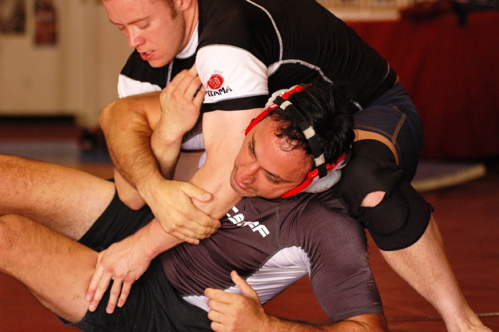 Flow rolling is one of my favorite training techniques for BJJ and a topic that I may expand on for a future article for Grapplearts.
Flow rolling is one of my favorite training techniques for BJJ and a topic that I may expand on for a future article for Grapplearts.
Let’s start with a definition: flow rolling is when 2 BJJ’ers move through many ground & submission positions without using strength and without pausing in any one position for a long time. The emphasis of flow rolling is on the transitions, recognizing submission opportunities, and creating combinations and counters. To see it in action, search for Marcelo Garcia flow rolling with other elite level grapplers on Youtube.
In the regular BJJ sparring, each opponent tries to impose their “A game” on a fully resisting opponent who is also trying to give as good as he gets. With 2 evenly matched opponents, there may not be much movement or many changes of position during a match, as neither opponent is willing to surrender a hard-fought-for position. This type of training is necessary to deal with the reality of an opponent’s pressure and intensity. It is, however, not the best training method for developing the flow in between your positions, or to introduce new techniques into your game.
Every time you try a new technique in sparring it increases the chance of you ending up in tough position. This can be a strong psychological deterrent from trying new techniques in a high intensity roll. Since a new technique is unpolished there is a pretty good chance that it will be countered and that you’ll end up in a worse position.
This fear of losing is valid, but it results in you sticking to your known arsenal of techniques. Historically the triangle from guard has always been a weak position of mine (damn these short legs!). I was recently trying to develop a new triangle choke setup from guard during regular rolling. Guess what happened every time I tried my fledgling triangle setup? My 250 lbs. opponent would shuck my legs aside, and pass to side control, and then I’d be facing an uphill battle to regain my guard. Why would I try to triangle a second time if the same result will likely happen? Soon, my once promising triangle setup is on the shelf, and I go back to my tried and true techniques that will allow me to survive. Unfortunately my triangle may never improve with this strategy…
In contrast, a flow rolling approach will result in many more exchanges of position and many more opportunities in the roll to try your new triangle setup. Who cares if your technique fails? It doesn’t matter because your training partner will be allowed to run a sequence of moves or advance position before allowing you to move and work a few techniques.
In flow rolling you can go ahead and try those awkward and inefficient attempts at a new technique. Now you can learn those subtle aspects of body position, weight distribution, timing and recognition of trigger positions unhindered by the fear of losing. At this point you are on your way to adding a new technique to your game.
Other benefits to flow rolling include:
- Learning how your opponent will react in the ‘tree of possibilities’ for each position,
- Recognizing submission trigger positions while you are still in transition,
- Extending training time from short intense matches to longer, lower intensity rolls,
- Creating less wear and tear on the body due to uncontrolled forces in hard rolling,
- Improving your scrambling & transitioning skills, which lead to a more dynamic, less static style of BJJ
Here’s a quote from an entrepreneur that sums it up: “40 hours a week is what we all have to do to take care of our financial responsibilities; it is what you do after that, over and above those 40 hours, that determines how successful you will be.”
Open mat sessions are not a substitute for regular attendance at BJJ class with a blackbelt instructor, but for those looking to maximize their BJJ development, creative open mat times are invaluable!
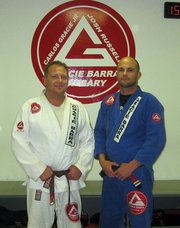 About the Author: Mark Mullen was one of Stephan Kesting’s very first BJJ training partners. He is now based in Calgary and was awarded his BJJ brown belt by Josh Russel at GracieBarraCalgary.com. Mark is also a brown belt in Judo. Other articles by Mark Mullen on the Grapplearts site include:Four Reasons You Might Be Getting Tired in BJJ, Training BJJ in Brazil. Also, click here for Stephan Kesting’s posts about training BJJ, MMA and Submission Grappling About the Author: Mark Mullen was one of Stephan Kesting’s very first BJJ training partners. He is now based in Calgary and was awarded his BJJ brown belt by Josh Russel at GracieBarraCalgary.com. Mark is also a brown belt in Judo. Other articles by Mark Mullen on the Grapplearts site include:Four Reasons You Might Be Getting Tired in BJJ, Training BJJ in Brazil. Also, click here for Stephan Kesting’s posts about training BJJ, MMA and Submission Grappling
|
The post 5 Ways You Can Best use Open Mat in BJJ appeared first on Grapplearts.
